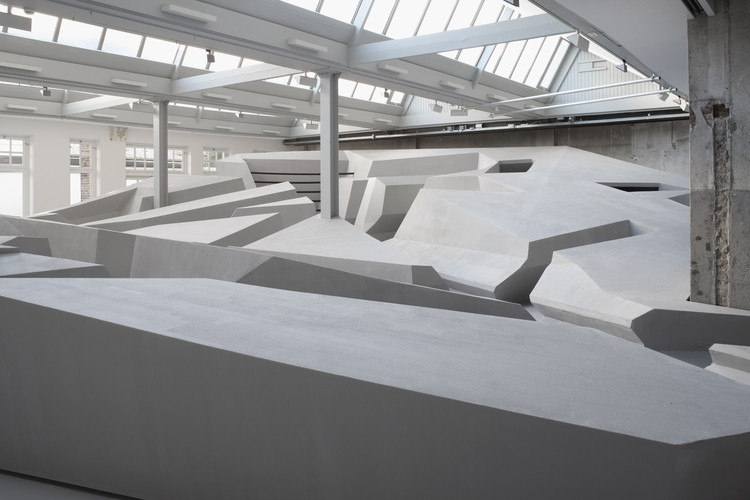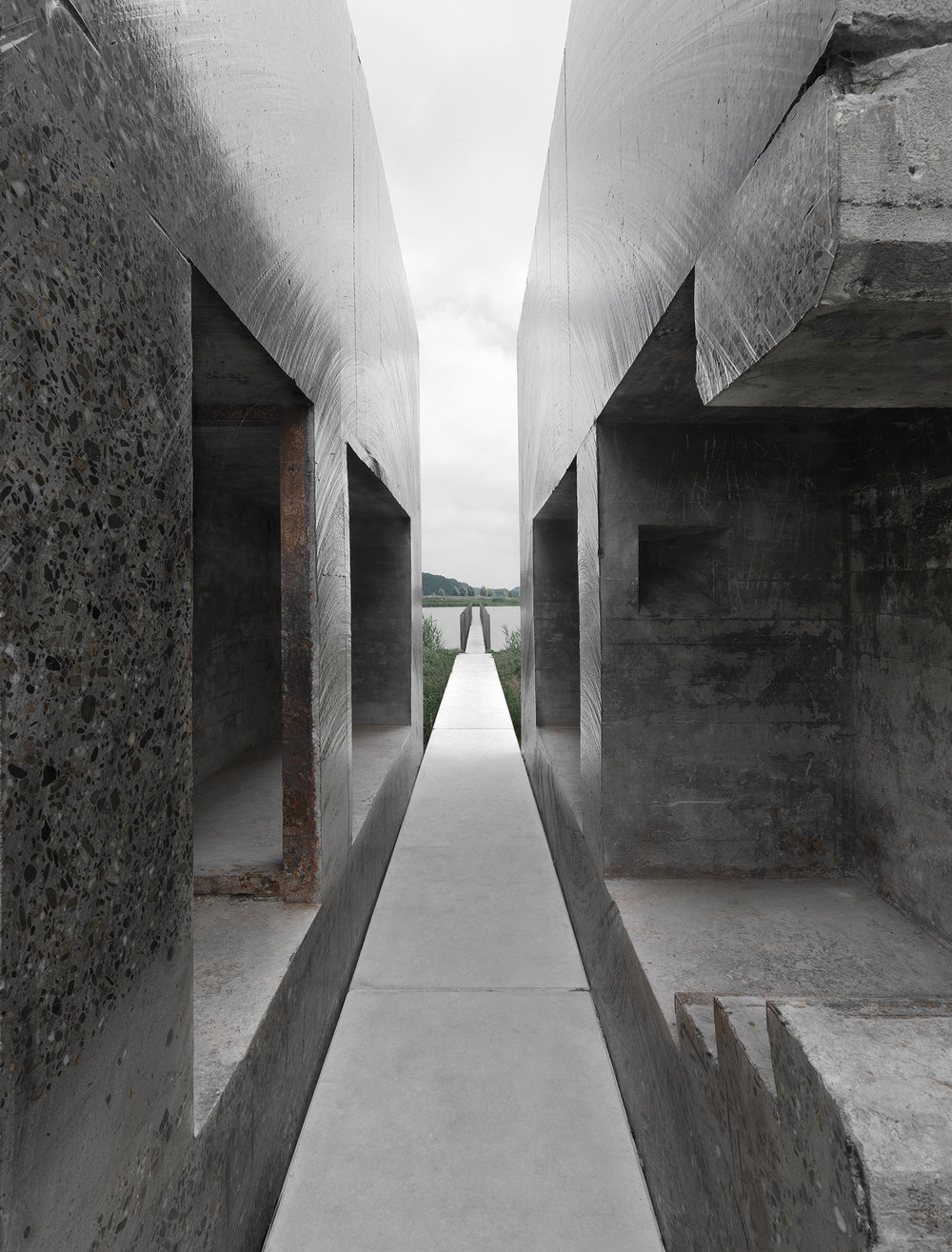With Every Project - A Manifesto
Ronald Rietveld
inter·punct speaks with Ronald Rietveld about vagueries of definitions, relationships between art and architecture, and unabashed iconoclasm.

i•p:
You mentioned that within your work there is no line between art and architecture. Can you describe what you mean with the mantra: “Architecture: there’s no definition”?
Ronald Rietveld:
You saw that the work focuses on a lot of different things—publishing, theories, manifestos. It’s about building objects and public spaces. All of our work is site-specific spatial design and responds to the local situation. The reason that we choose to work on the border of art and architecture is because it offers us the possibility to compromise less in our way of working. With art I think you can lay bare layers, which is more difficult through architecture because architecture starts with the program, and we start with nothing. We start with no program - just the opposite. That’s good from the perspective of art, because it delivers a freedom to think about architecture without all of its predefined occupations or styles.
Avoid compromise. Anything can be a headliner. And with every project, build a manifesto.
i•p:
You also spoke about the importance of staging strategic interventions. How do you decide which problems to address?
RR:
We always start with our own fascinations. At certain moments there is this cloud of subjects which interest you, and if you get enough questions that come up about an issue you want to bring it up in Venice. We thought vacancy is the one and this was the moment to do it. Both in relation to the political situation in the Netherlands, and because the rest of the world didn’t yet view the topic of vacancy as a major issue. We thought there was a huge potential because in the Netherlands there is always a story about money, subsidizing, and funding. We said okay, stop funnelling the money away and give us the keys. These buildings are in the middle of the city, we have many people who need space at this moment in our densely populated country and these buildings are unique to our heritage. They are schools, hospitals, water towers, lighthouses, bunkers, fortresses, nunneries, monasteries—everything that we the public have paid for and are still paying taxes for. We thought we should do something with these buildings which gives back to the whole society. It was a new political agenda: a knowledge and innovation agenda. We said, okay, if you want knowledge and innovation, the overwhelming necessity for space is a good place to start. It was impossible to come up with a program for ten thousand buildings, so we thought we should just reveal the potential instead. The Dutch Atlas of Vacancy is actually defining the potential of single buildings in all kinds of senses. Is it close to a university? How is it related to a knowledge network? The whole process took five months, from when we received the question to the Venice Biennale.
i·p:
What are your views on the term vacancy, and how do you think we as a society can critically deal with those prejudices in regards to reusing these spaces? Specifically, how can your practice provoke some sort of change?
RR:
We just want to show new thinking models because we can’t solve all problems. All of these buildings are site-specific—you can’t solve all problems at once. Cities shouldn’t do that either. Many buildings must happen in circumstances where normal buildings are not possible, so you have to come up with other ways of making architecture. So what is it? Is it architecture, art, installation, or something in between? It opens up a new perspective on making a new built environment. We always look around. We always try to look at larger scales, and influences that are interesting for choosing a certain direction for a building or a built environment. We never focus on the object. You see a lot of objects in the end, but they are the result of another way of thinking. The object is the medium, although it should be carefully designed. It should be very precise in what you want to say and what you want to tell. It should be beautiful in the end, of course, but the range from the strategy to the details should be very clear, sharp as a knife.
i•p:
How do these objects interface with human actors?
RR:
So you put something on the agenda and you open up the perspective that can, in the end, become part of the daily work. But that’s not our aim; we show the long-term perspective by making physically tangible things which you can experience now, today. We also try to make a total installation, it is important for us that it’s a complete experience. I hate the word experience, actually, because it’s been taken over by marketing, but it is important to have a total experience in some concern. It might be in service of making things clear, bringing them to a deeper level.
i•p:
How does your atlas serve at the scale of both your practice and a larger global stage?
RR:
We always try to think along the lines of scale, so even though we are busy with objects or whatever, it’s related to a bigger idea. For Vacant NL, the atlas gives a tool for working in places, more in the way of thinking than literally. It’s more about keeping an open perspective. I don’t believe in the toolbox idea that for certain types of buildings you can use this or this or this. In all of our work, even on the level of detailing things, we still always have the bigger picture in mind. I think this is specific to our studio. All cities are so diverse. We want to point out that it’s not about a blue foam city, it’s about single unique buildings. In the end it looks like a sea, but every single building has its own site-specific context embedded within it. If you think from this idea, in the case of knowledge development in the Netherlands, that’s what the atlas is about. It’s pointing at the knowledge network, trying to find new relationships to the context, and coming up with new programs.

i·p:
The concept of subtraction of space comes to mind. You often operate in these spaces and subtract from them, like in Bunker 599.
RR:
Many people don’t know how to deal with absence, they want to fill it up and come up with a program. But to give meaning to absence—and absence doesn’t mean there is nothing—we often take things away instead of adding things. Everybody is adding things. The world is filled with stuff and images, so maybe we should start removing them instead of adding. From the moment architects begin thinking about a building, they should also think, how will it be removed afterwards?
i·p:
In concepts of heritage and monument, how society treats historical buildings; How do you let go of this sense of permanence, and can it be applied in conventional architectural practice?
RR:
We always try to connect present, past, and future in every project. It’s a moment in a timeline. You are doing an intervention, and even when it’s completely done, afterwards it continues. So what is going to happen then? And this is what strategic interventions are. They have an idea about what something could be, not what it should be. We just have a new development in motion, but fifty years after us somebody could come to this site, and what is going to happen? So it’s liberating to actually think in this way about your profession. Most architects think they build for eternity, and some have done that in the past in a very extreme way. But also, it’s a myth. It’s really about provocation and subversive interventions. There shouldn’t be the possibility to avoid it without provoking an opinion. Whether you like it or not, you cannot avoid the intervention.

i·p:
You spoke about being subversive, have you ever considered this a type of guerrilla architecture?
RR:
Friction is necessary. Everything is easy now, we try to conform to everything and avoid conflict. But it’s also a way of thinking about society. In our practice we make projects for the public about confronting instead of avoiding subcultures, making more specific domains for groups which are actually available and accessible for everybody, but owned by specific groups. Then you get a different kind of taste of another culture. It sounds superfluous, but we believe in a kind of confrontation, the world of neat and the world of freaks next to each other.
i·p:
How do you engage students in this conversation? What’s the process in the studio that you lead?
RR:
It was a very intensive process. I liked that it wasn’t just about talking, but about making. Of course we always write about our work; there’s a build manifesto and the relation to text is important, but in the end we also want to have it physically as well. You should touch the materials, it should become tangible, because then it becomes something to communicate and becomes intrinsic architecture rather than architecture on paper. Don’t fall into the trap of doing many projects. No. Do less projects, but really well. In America, of course, you go bigger and bigger, but look at every practice that has begun and compare the work they made in the beginning to the work they make now. In the beginning everything is sharp and clear, and once they expand it becomes less good. It’s the same with every office around the world. And it’s not that they don’t make any good projects anymore, but that their portfolio is diluted.
·